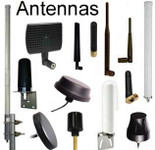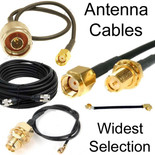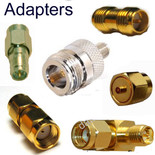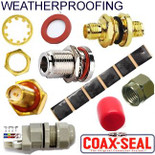Antennas, Antenna Cables, Wireless Products: Technical Articles
Comparing RF Connectors: SMA vs. N-Type vs. TNC vs. BNC
Table of Contents
Comparative analysis of SMA, Type-N, TNC, and BNC antenna connectors
Coaxial antenna cable connectors play a vital role in ensuring the reliable transmission of radio frequency (RF) signals. Among the many connector types, SMA, RP-SMA, N-Type, BNC, and TNC connectors are some of the most commonly used. Each has unique characteristics and is suited to specific applications. This article provides a comparative analysis of these connectors, examining their features, advantages, and typical use cases.
SMA (SubMiniature Version A) Connectors
Characteristics:
SMA connectors are small, threaded connectors designed for frequencies up to 18 GHz (and higher in precision variants).
They feature a male connector with a center pin and a female connector with a center sleeve.
Advantages:
Compact size and lightweight design.
Excellent performance at high frequencies.
Threaded interface ensures secure connections, even in vibration-prone environments.
Ideal Use Cases:
Wireless communication systems (e.g., Wi-Fi, cellular).
Test and measurement equipment.
Aerospace and defense applications requiring precision and reliability.
RP-SMA (Reverse Polarity SMA) Connectors
Characteristics:
RP-SMA connectors are a variation of SMA connectors with reversed gender assignments of the center pin and sleeve.
Commonly used in wireless systems to comply with FCC regulations by preventing unauthorized antenna changes.
Advantages:
Maintains the high-frequency performance of SMA connectors.
Ensures regulatory compliance in certain wireless devices.
Typical Use Cases:
Antennas and antenna cables for Wi-Fi devices of all kinds, including routers and access points.
Bluetooth, ZigBee and LoRaWAN wireless communication devices.
N-Type Connectors
Characteristics:
N-Type connectors are medium-sized, threaded connectors supporting frequencies up to 11 GHz (standard versions) or 18 GHz (precision versions).
Designed for outdoor and high-power applications, they feature weatherproof construction.
Advantages:
Excellent durability and weather resistance.
Capable of handling higher power levels compared to SMA or RP-SMA.
Stable performance at higher frequencies.
Ideal Use Cases:
Base stations and outdoor antennas.
Military and aerospace systems.
High-power RF applications.
BNC (Bayonet Neill-Concelman) Connectors
Characteristics:
BNC connectors feature a quick-connect bayonet coupling mechanism.
Designed for frequencies up to 4 GHz, but typically used below 1 GHz.
Advantages:
Easy and quick to connect and disconnect.
Suitable for low-frequency applications.
Widely available and cost-effective.
Ideal Use Cases:
Test equipment (oscilloscopes, signal generators).
Video transmission systems (CCTV, broadcast).
Low-frequency RF systems.
TNC (Threaded Neill-Concelman) Connectors
Characteristics:
TNC connectors are threaded versions of BNC connectors, providing better performance at higher frequencies (up to 12 GHz).
They share the same internal design as BNC but with a threaded coupling.
Advantages:
Improved vibration resistance compared to BNC.
Better performance at higher frequencies.
Typical Use Cases:
Mobile communication systems.
Radar and military systems.
High-frequency RF and microwave applications.
RP-TNC is the Reverse-Polarity version of TNC that is typically used for Wi-Fi applications.
Comparison Table
| Connector Type | Frequency Range | Coupling Mechanism | Key Advantages | Ideal Applications |
|---|---|---|---|---|
| SMA | Up to 18 GHz | Threaded | Compact, high-frequency | Wireless, test equipment, aerospace |
| RP-SMA | Up to 18 GHz | Threaded | Regulatory compliance | Wi-Fi devices |
| N-Type | Up to 18 GHz | Threaded | Durable, high-power | Outdoor antennas, base stations |
| BNC | Up to 4 GHz | Bayonet | Quick-connect, cost-effective | Video systems, test equipment |
| TNC | Up to 12 GHz | Threaded | Vibration-resistant | Mobile, radar, high-frequency RF |
Conclusion
Selecting the right coaxial connector depends on the specific requirements of your application. SMA and RP-SMA connectors excel in compact, high-frequency systems, while N-Type connectors are ideal for high-power and outdoor uses. BNC connectors are perfect for low-frequency and quick-connect needs, whereas TNC connectors offer a robust alternative for higher frequencies and vibration-prone environments. Understanding these differences ensures optimal performance and reliability in your RF systems.
FAQs
What are the main differences between SMA, RP-SMA, N-Type, BNC, and TNC connectors?
Each connector type has unique characteristics:
- SMA: Compact, threaded, high-frequency up to 18 GHz.
- RP-SMA: Similar to SMA but with reversed polarity for regulatory compliance.
- N-Type: Medium-sized, durable, handles higher power, weather-resistant.
- BNC: Quick-connect, low-frequency (up to 4 GHz), widely used in video/test gear.
- TNC: Threaded version of BNC, supports up to 12 GHz, more vibration-resistant.
Where are SMA connectors typically used?
SMA connectors are common in wireless communication systems, aerospace and defense, and test equipment because of their compact size, secure threaded coupling, and excellent high-frequency performance.
Why were RP-SMA connectors developed, and where are they used?
RP-SMA connectors were designed to meet FCC regulations by preventing unauthorized antenna swaps. They are widely used in Wi-Fi routers, access points, Bluetooth devices, ZigBee, and LoRaWAN systems.
What makes N-Type connectors suitable for outdoor and high-power applications?
N-Type connectors feature weatherproof construction, high durability, and the ability to handle higher power levels. This makes them ideal for base stations, outdoor antennas, and military or aerospace systems.
What are the advantages and limitations of BNC connectors?
BNC connectors are quick and easy to connect/disconnect, inexpensive, and widely available. However, they are best suited for low-frequency applications below 1 GHz, such as test equipment, CCTV, and broadcast video systems.
How do TNC connectors improve on BNC connectors?
TNC connectors use a threaded coupling instead of bayonet locking, which improves vibration resistance and allows reliable operation up to 12 GHz. They are commonly used in mobile communication, radar, and high-frequency RF/microwave applications.
What is RP-TNC, and how is it different from TNC?
RP-TNC is the reverse-polarity version of the TNC connector. It is mainly used for Wi-Fi devices, similar to how RP-SMA is used for regulatory compliance in wireless networks.
How do I choose the right connector for my application?
Selection depends on frequency range, power requirements, environment, and ease of connection:
- Choose SMA/RP-SMA for compact high-frequency wireless devices.
- Choose N-Type for outdoor/high-power systems.
- Choose BNC for low-frequency or quick-connect needs.
- Choose TNC for higher frequencies and vibration-prone environments.







